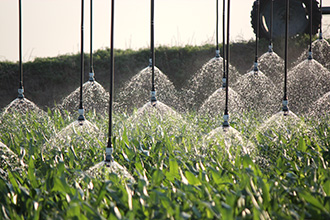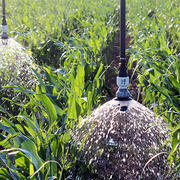
LEPA (Low Energy Precision Application) technology introduced a revolutionary concept in the mid 80’s when center pivot irrigators were mostly using top-of-pipe impact sprinklers operating at high pressures. Growers needed more efficient applicators that could irrigate at lower pressures to reduce pumping requirements. They also needed products and practices to combat wind-drift and evaporative loss, especially in areas affected by declining water availability.
A collaboration between researchers from Texas A&M and sprinkler manufacturer Senninger Irrigation led to the development of the first LEPA applicator. Researchers found that LEPA sprinklers mounted near the soil surface proved beneficial in water and energy savings without affecting yield.
In areas where water availability is a concern, growers looked again at the LEPA bubblers spaced with 40” or less between hose drops to distribute water over most of the soil surface. Senninger Vice President Mark Healy expanded his initial LEPA concepts to create bubbler pads and shrouds for these close-spaced LEPA installations.
In-field testing
The LEPA close spacing project began in Nevada. The climate is windy with little rainfall and very low humidity. The soil is heavy silt clay loam. John Maurer from Triple D Ranch in Dyer, Nevada, explains, “The groundwater basin here is depleting like most in any heavily irrigated area. It became a concern.” Maurer was looking to reduce water loss to wind drift and evaporation and still maintain his yields. He went on to add, “When we started using these [LEPA close spacing bubblers] and saw what they would do to cut that out, that was a big motivation, because it's all about efficiency.” He discovered LEPA Close Spacing bubblers with a shroud outperformed standard sprinklers over alfalfa. This past growing season, his LEPA installations produced an average of 21.5 percent more bales and 6.5 percent more tonnage during four cuttings on three pivots. The water rests on the soil surface and slowly infiltrates producing lateral movement and leaches salts beneath the root zone.
Another project participant was grower Bob Holloway in Mingo, Kansas. The climate is windy with little rainfall and very low humidity. The soil is heavy silt loam. Holloway was able to farm 50 percent more corn, a total of 120 acres, with just 250-300 gpm thanks to LEPA technology. “The situation that we were in required us to either give up one irrigated circle or find a more efficient means of irrigating,” he says. “With the LEPA bubbler system, we use the the water we have available in a more productive way, resulting in less surface moisture and more beneficial subsoil moisture.”
Irrigation dealers also see the LEPA Close Spacing benefits. Rick Grimes, owner of Southwest Irrigation in southwest Arizona, says that areas of Arizona and the Imperial Valley in California experience summer temperatures of 118°F to 120°F and evapotranspiration rates between 0.6 and 0.7 inches a day. As Grimes explains, “This means a farmer with 320 acres of land will need at minimum 12 gpm per acre just to offset the ET rates. LEPA sprinklers closer to the ground let growers irrigate more acres by reducing water loss.”
Rod Stillwell with American Irrigation in Garden City, Kansas, was another project participant in this project. Weather conditions in that area are usually windy and dry. According to Stilwell, “The main crops around here are corn, wheat, soybeans, milo, alfalfa, and potatoes. With Close Spacing, growers are seeing that they can shut down their systems more often, therefore, saving water and energy. It's a cost-effective way to produce good yields.”
Focus on results
LEPA close spacing installations, when combined with conservation tillage, average over 95% efficiency in water use. In addition to reduced wind-drift and evaporation loss, and less energy consumption, LEPA close spacing helps
- produce a more uniform root zone coverage.
- increase yield using less water.
- leach salts beneath the root zone.
- avoid wetting the plant canopy in row crops.
- apply the water needed in fewer pivot passes.
The participants in this project are confident LEPA close spacing will help growers in dry, windy areas around the world save water and energy and increase yields.
This close-spaced LEPA installations project was recently honored as the agriculture Vanguard Award winner during the 2017 Irrigation Show and Education Conference. This award is presented to honor a project that has executed an innovative installation project in the irrigation industry.
Source
Originally published as "Lower Pressure for higher Efficiency" Irrigation Today. April 2018.




